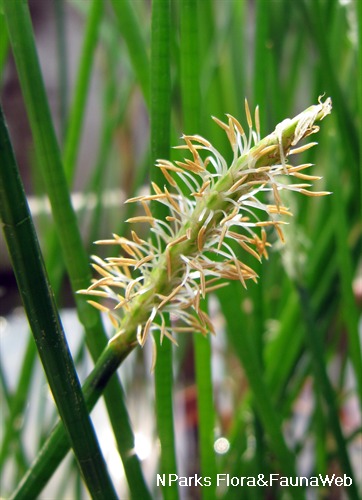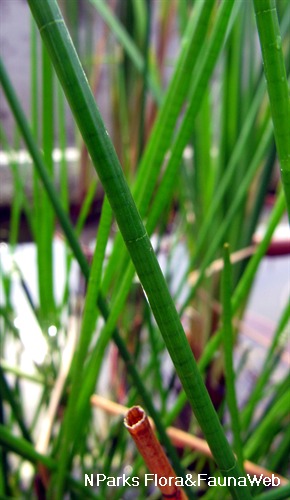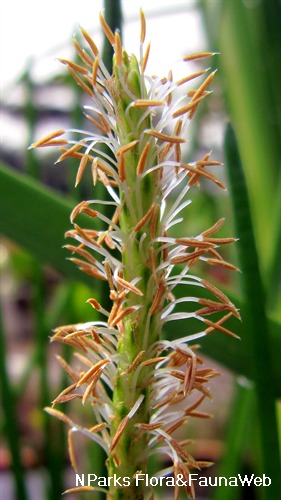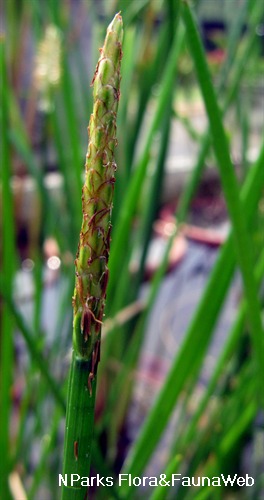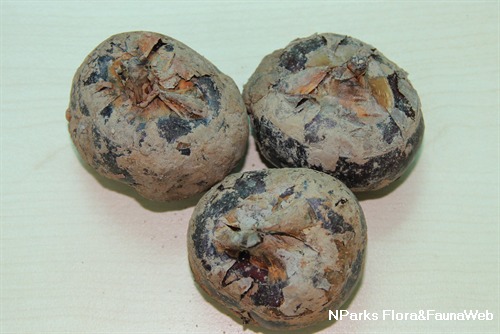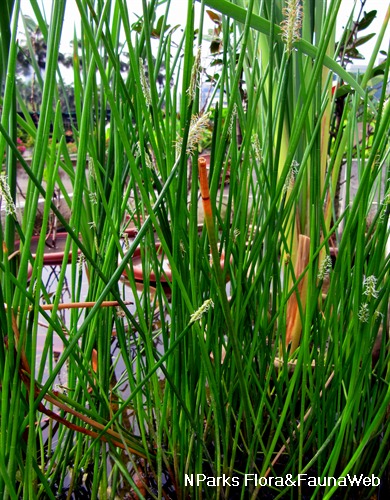
Back
Eleocharis dulcis (Burm.f.) Trin. ex Hensch.
| Family Name: | Cyperaceae |
| Synonyms: | Andropogon dulce Burm.f., Scirpus plantaginoides Rottb., Eleocharis plantaginoides (Rottb.) Roem. & Schult., Limnochloa plantaginoides (Rottb.) Nees, Scirpus tuberosus Roxb., Eleocharis tuberosa Schult., Eleocharis dulcis var. tuberosa (Schult.) T.Koyama, Eleocharis equisetina J.Presl & C.Presl |
| Common Name: | Water Chestnut, Chinese Water Chestnut, 马蹄, 荸荠 |
Name
Classifications and Characteristics
| Plant Division | Angiosperms (Flowering Seed Plants) (Monocotyledon) |
|---|---|
| Plant Growth Form | Aquatic & Hydrophyte |
| Lifespan (in Singapore) | Perennial |
| Mode of Nutrition | Autotrophic |
| Maximum Height | 40 cm to 90 cm |
Biogeography
| Native Distribution | From Western Africa, Japan, Southeast Asia (including Singapore) to Australia |
|---|---|
| Native Habitat | Aquatic (Freshwater Pond / Lake / River, Brackish Pond / Lake / River) |
| Preferred Climate Zone | Tropical, Sub-Tropical / Monsoonal |
| Local Conservation Status | Native to Singapore (Vulnerable (VU)) |
Description and Ethnobotany
| Growth Form | Perennial herb up to 0.9 m tall. |
|---|---|
| Stems | Aboveground stems known as culms are cylindrical, spongy and connected at the base in tufts (40-90 cm long, 3-7 mm wide). Underground, horizontal stems known as stolons form edible tubers at the tip which are globose, but slightly flattened and rich in starch. Tubers of wild plants are 5-7 mm wide, while those of cultivated plants may be 2-5 cm wide. |
| Flowers | The inflorescence is a narrow, cylindrical spikelet (20-50 mm long, 3-4 mm wide). |
| Fruit | The fruit is a glossy, yellowish or greyish-brown nutlet (1.7-2.2 mm long, 1.5-1.8 mm wide). The nutlet is obovate (egg-shaped with the narrow tip at the bottom) or biconvex (lens-shaped). |
| Habitat | It tends to form large stands in both coastal and inland marshy areas. In Singapore, it was recorded in MacRitchie (2019) and Sungei Buloh (2002). |
| Associated Fauna | It is the preferred local food plant for the caterpillars of the moth sugarcane top borer (Scirpophaga nivella). |
| Cultivation | Plants cultivated for the edible tuber are propagated by planting the tuber. |
| Etymology | Greek Eleocharis, marsh-favouring, referring to the habitat of the plant; Latin dulcis, sweet, referring to the sweet-tasting tuber. |
| Ethnobotanical Uses | Edible Plant Parts : Edible Storage Organs Food (Fruit or Vegetable): The tubers are eaten raw or cooked and added to soups, salads or vegetable dishes. Medicinal: The tubers are used in traditional Chinese medicine to treat measles, improve vision and cure eye diseases. Others: The culms are used to make mats in Sumatra. The tubers are used to produce starch. |
Plant Care and Propagation
| Light Preference | Full Sun |
|---|---|
| Water Preference | Lots of Water, [Remarks] (The soil should be kept flooded with 100mm to 300mm of water throughout the growing period.) |
| Plant Growth Rate | Fast |
| Maintenance Requirements | Moderate |
| Propagation Method | Seed, Storage Organ (Corm, Rhizome), Division |
Floral (Angiosperm)
| Flower Colour(s) | Yellow / Golden |
|---|---|
| Flower Grouping | Cluster / Inflorescence |
| Flower Location | Terminal |
| Inflorescence Type | Spikelet / Compound Spike |
Image Repository
Others
| Master ID | 31073 |
|---|---|
| Species ID | 5462 |
| Flora Disclaimer | The information in this website has been compiled from reliable sources, such as reference works on medicinal plants. It is not a substitute for medical advice or treatment and NParks does not purport to provide any medical advice. Readers should always consult his/her physician before using or consuming a plant for medicinal purposes. |

